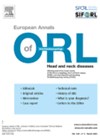Quinsy and culture
Peritonsillar abscesses are frequently encountered in clinical practice. Standard treatment includes empirical medical treatment and drainage. This study aimed at evaluating the value of culture and sensitivity testing of the aspirate in guiding antibiotic treatment. Patients received empirically amoxycillin, amoxycillin...
How good is secondary intention healing post nasal cutaneous tumour excision?
The variation in size and site of nasal cutaneous tumours allows the surgeon to propose various methods to close the resulting defect post-tumour excision. This prospective multicentre cohort study executed in China encompassed 150 patients, comparing wound healing times and...
Will getting a rhinoplasty make you feel better?
“The National Health Service is in serious trouble.” This is the opening line of the introduction of Lord Darzi’s report to the Secretary of State for Health in England. His deep dive into the current state of the NHS in...
How would you like your cartilage served – diced, crushed or shaved?
Harvested cartilage can be used to enhance the structural, functional and aesthetic properties of the nose in rhinoplasty. The practice of mechanical fragmentation of harvested cartilage in rhinoplasty is varied with no clear consensus with respect to its indication. This...
Can a serpent-shaped graft enhance your nose?
The success of rhinoplasty is highly variable and the technique employed by the operating surgeon must be tailored for different patient demographics. This group from China describes the structural differences in nasal configuration within the Asian population, notably an under-projected...
Septal perforation healing
This Turkish animal-based study looked at the healing properties of Hypericum Oleum (HO, or St John’s wort) and Triticum vulgare (TV, or wheat germ oil) on nasal septal perforations in rats. Both HO and TV have wound healing properties and...
How satisfying can a rhinoplasty be?
Rhinoplasty has seen an exponential rise in its uptake over the last few decades globally, offering patients a way to surgically correct the external appearance of the nose with the aim to improve cosmesis. Whilst the success of the procedure...
Corticosteroid prescribing in ENT - are we at risk of being sued?
Of medications leading to malpractice claims, corticosteroids comprise the third most common. They are used widely and have a significant side-effect profile: hypertension, lipodystrophy, diabetes, avascular necrosis of the femoral head, peptic ulceration and psychiatric reactions to name but a...
Age and vocal cord carcinoma
As the population ages, the management of vocal fold carcinomas should be evaluated. In this retrospective study on 33 patients aged 75 and more, the authors compared the results of radiotherapy and endoscopic treatment for T1 and T2 glottic carcinoma....
Predicting outcomes in rhinology using fluid dynamic models
This article discusses the rhinological applications of computational fluid dynamics (CFD) – a method derived from engineering applications, such as aerodynamics. Its appeal is that it can provide simulated data on airflow velocity, pressure, resistance, temperature, humidity, heat flux and...
Evaluating the nose
Objective evaluation of the nose before and after rhinoplasty is not standard. The authors adapted the MiRa scale after translation to French to be validated. For a better practical approach, the translation was conceptual rather than literal and followed five...
Performing ethnic aesthetic rhinoplasty
This article reviews principles of performing rhinoplasty in non-Caucasian patients, exploring patient expectations based on differences in race, ethnicity and culture. One of the main challenges is a lack of well-established ideal facial measurements for different non-Caucasian groups. The authors...


















